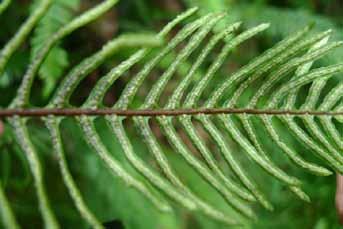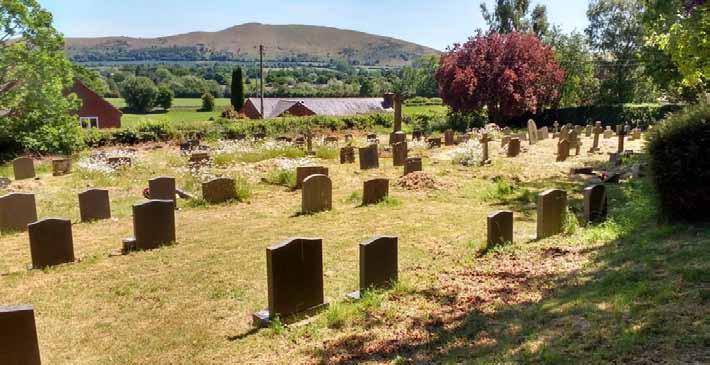
5 minute read
Caring for God’s Acre
Polypodium interjectum has around 7–10 indurated cells and usually 2 quite large basal cells, there is no real overlap with P. vulgare. Fig 8. Polypodium cambricum has a similar pattern of cells in its sporangia to P. interjectum with quite a bit of overlap in indurated and basal cell numbers (typically around 5 – 10 indurated cells and around (2) 3 basal). This makes the identification confirmation using sporangia unreliable. Instead we look for paraphyses amongst the sporangia on our slide – these are fine branched “hairs” which do not occur in the other two species (Fig 9.).
A potential confusion species
Advertisement
A possible confusion species for the novice is Struthioperis spicant (formerly Blechnum) which is also once-pinnate and looks a bit like Polypodium. However this plant grows in neat compact tufts and, later in the year, produces leaves with a long, slender, shape which have linear sori on their undersurfaces, Fig 10 and 11. Also note that, unlike Polypodium, Struthiopteris leaves taper downwards to their base giving them a long narrow elliptical profile with a very short stipe.
Fig 10. Struthiopteris spicant

Fig 11. Underside of a S. spicant fertile frond showing sporangia
Liam Taylor
Introduction
I offer a further update on behalf of Caring for God’s Acre, a Shropshire based conservation charity whom you are hopefully acquainted with by now. In autumn 2019 I wrote about the recording that had taken place over the preceding months. This spring I wrote an update which included some maps and a list of unrecorded churchyards in Shropshire. As I did previously, I offer a disclaimer – apologies if I miss anyone off, I have various lists and emails to check to remind me of who has submitted what and when. In addition, I only list the records we at Caring for God’s Acre have been made aware of via email or iRecord etc. In this update I have tried to pick out species which might be interesting or unusual. Unfortunately, I am not a very accomplished botanist so you will have to excuse me if I point something out and you think “So?”.
Recording in 2020
2020 has provided opportunities and challenges for recording in burial grounds. Churchyards that are usually mowed with fervent regularity were allowed to grow their hair out for a change. Scores of lawnmowers laid dormant in garages, their owners looking wistfully out of their windows remembering better days when they were able to ‘keep on top’ of the grass. Just think of all those dandelions… A perfect opportunity for recorders to finally see what treasures these sites were hiding. Well, it didn’t quite work out like that. Whilst some recorders were able to visit burial grounds as part of exercise allowances, that wasn’t feasible for many people. Since restrictions were eased, it has been easier for many to visit burial grounds again, but many of us are still far from usual routines and activities. Of course, most mowing regimes are back in full swing as well now. January: Vicky Barnes was birding in Hope Bagot and Worfield churchyards, where she managed a spot of winter botany as well. Dan Wrench was looking at Yew trees in St Giles, Shrewsbury where he found a gall that grows on Yew trees, Taxomyia taxi. February: Peter Johnston managed a double header of Clun and Clunbury churchyards. March: Brenda Dyson was recording in St Mary’s church in the charming village of Bucknell, and both
Harriet Carty and Peter Johnston shared records from Caynham churchyard – I hear it is well worth a visit. May: Isabel Carter was at Smethcott churchyard recording birds (House Martin, Sparrowhawk, Spotted flycatcher, Swallow), mammals, invertebrates, and trees. Michael Carter completed a hat-trick of surveys this year, Leebotwood: St Mary, Woolstaston: St Michael and All Angels, and Smethcott: St Michael. Smethcott was something of a write off straight away, mown like a billiard table. Leebotwood and Woolstaston both held promise however. Michael made more visits in May, and July, and unfortunately, both churchyards got mown. These are the challenges we are up against unfortunately. It can take a tremendous amount of effort and persuasion to change management regimes. Nonetheless, it can happen and often it comes off the back of an enthusiastic individual taking an interest in a site. June: Andrew Perry was recording in St Andrew’s church in Church Aston, Newport. There he found Walnut, Hop Trefoil, and Rat’s-tail Fescue. Sandra Spence was in Hopesay, giving this charming churchyard some more attention – a site appreciated by many as far as I can tell. John Handley had recently discovered that Holy Trinity, Coalbrookdale was the burial place of Abraham Darby IV and his wife Matilda, and duly paid it a visit. There he found Heath False-brome Brachypodium pinnatum, which has also been found in Shrewsbury Cemetery and perhaps adds credence to a theory that it has been brought in with limestone chippings. John has written a lovely piece on his visit to the churchyard, well worth a read. July started with some photos of Bicton churchyard from Andrew Law, who informs me that this site is being mown less frequently with more plants flowering and occasional waxcaps popping up. Later in the month Rob Rowe visited Buildwas churchyard and recorded a respectable 60 species, with Black Horehound and Spring Sedge. Rob also visited St Edith’s Church, Eaton Under Heywood, 117 species recorded. August: Caynham gets another visit! Some churchyards get all the fuss don’t they? This time it was Rob Rowe visiting.
Summary
Thanks to all those who have shared their records. Perhaps I can provide another Spring update with maps and lists if there is a call for it. By the spring, the Lichfield and Hereford dioceses will be up on our burial grounds portal on the NBN Atlas, so that might provide further summary opportunities as well. If you haven’t yet looked at our burial grounds portal – search google for burial grounds portal nbn, and the first result should be correct. In other news, I recently produced a film for the Restoring Shropshire’s Verges Project. A worthy endeavour, hopefully just one of many more projects to come. The video is on the Caring for God’s Acre YouTube page if you would like to take a look. Liam Taylor, October 2020. liam@cfga.org.uk









